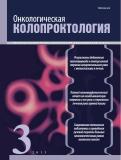RESULTS OF PANITUMUMAB ADDITION TO CONVERSION THERAPY FOR COLORECTAL CANCER LIVER METASTASES
- Authors: Sekacheva M.I.1, Paltseva E.M.1, Bagmet N.N.1, Bedzhanyan A.L.1, Polishchuk L.O.1, Skipenko O.G.1
-
Affiliations:
- Acad. B.V. Petrovsky Russian Surgery Research Center, Russian Academy of Medical Sciences, Moscow
- Issue: Vol 2, No 3 (2013)
- Pages: 11-17
- Section: IN FOCUS
- Published: 01.03.2015
- URL: https://onco-surgery.info/jour/article/view/88
- DOI: https://doi.org/10.17650/2220-3478-2013-0-3-11-17
- ID: 88
Cite item
Full Text
Abstract
Panitumumab has been shown to increase progression free and overall survival in patients with metastatic colorectal cancer.
Our purpose was to evaluate whether panitumumab is effective and safe in patients with potentially resectable colorectal liver metastases (CRLM).
Methods. Consecutive analysis of data from 11 patients (KRAS wild) receiving oxaliplatin-based chemotherapy and panitumumab as converse preoperative treatment for potentially resectable CRLM. At the moment of presentation R0-liver resection was not possible due to technical reasons (small remnant volume, large liver vessels involvement etc.). We studied objective response rate, surgical characteristics, skin toxicity profile, and perioperative course. Also expression of EGFR-ligands (transforming growth factor-α and amphiregulin) and expression of E-cadherin were studied.
Results. After median 6 courses of treatment, metastatic liver tumors were reduced considerably (PR) in 8 pts (73 %). Radical liver resection (R0) with 3 median number of removed segments was done in 6 (55 %) patients. Two pts underwent successfully the two-stage surgery (1 – portal vein embolization and 1 – portal vein ligation with partial left resection). Two patients progressed on chemotherapy (18 %). There was no correlation between skin toxicity and response. Mean blood loss was 250 ml. Preoperative administration of panitumumab was associated with higher risk of postoperative infection complication (57.1 %).
Conclusions. To the best of our knowledge this is the first report about using panitumumab as conversion therapy before liver resection. The panitumumab and oxaliplatine-based regimen may increase the resection rate of liver metastases and influence on adhesive and proliferative activity of cancer cells. It is necessary to focus on postoperative infection complications.
About the authors
M. I. Sekacheva
Acad. B.V. Petrovsky Russian Surgery Research Center, Russian Academy of Medical Sciences, Moscow
Author for correspondence.
Email: sekach_rab@mail.ru
Russian Federation
E. M. Paltseva
Acad. B.V. Petrovsky Russian Surgery Research Center, Russian Academy of Medical Sciences, Moscow
Email: sekach_rab@mail.ru
Russian Federation
N. N. Bagmet
Acad. B.V. Petrovsky Russian Surgery Research Center, Russian Academy of Medical Sciences, Moscow
Email: sekach_rab@mail.ru
Russian Federation
A. L. Bedzhanyan
Acad. B.V. Petrovsky Russian Surgery Research Center, Russian Academy of Medical Sciences, Moscow
Email: sekach_rab@mail.ru
Russian Federation
L. O. Polishchuk
Acad. B.V. Petrovsky Russian Surgery Research Center, Russian Academy of Medical Sciences, Moscow
Email: sekach_rab@mail.ru
Russian Federation
O. G. Skipenko
Acad. B.V. Petrovsky Russian Surgery Research Center, Russian Academy of Medical Sciences, Moscow
Email: sekach_rab@mail.ru
Russian Federation
References
Supplementary files






